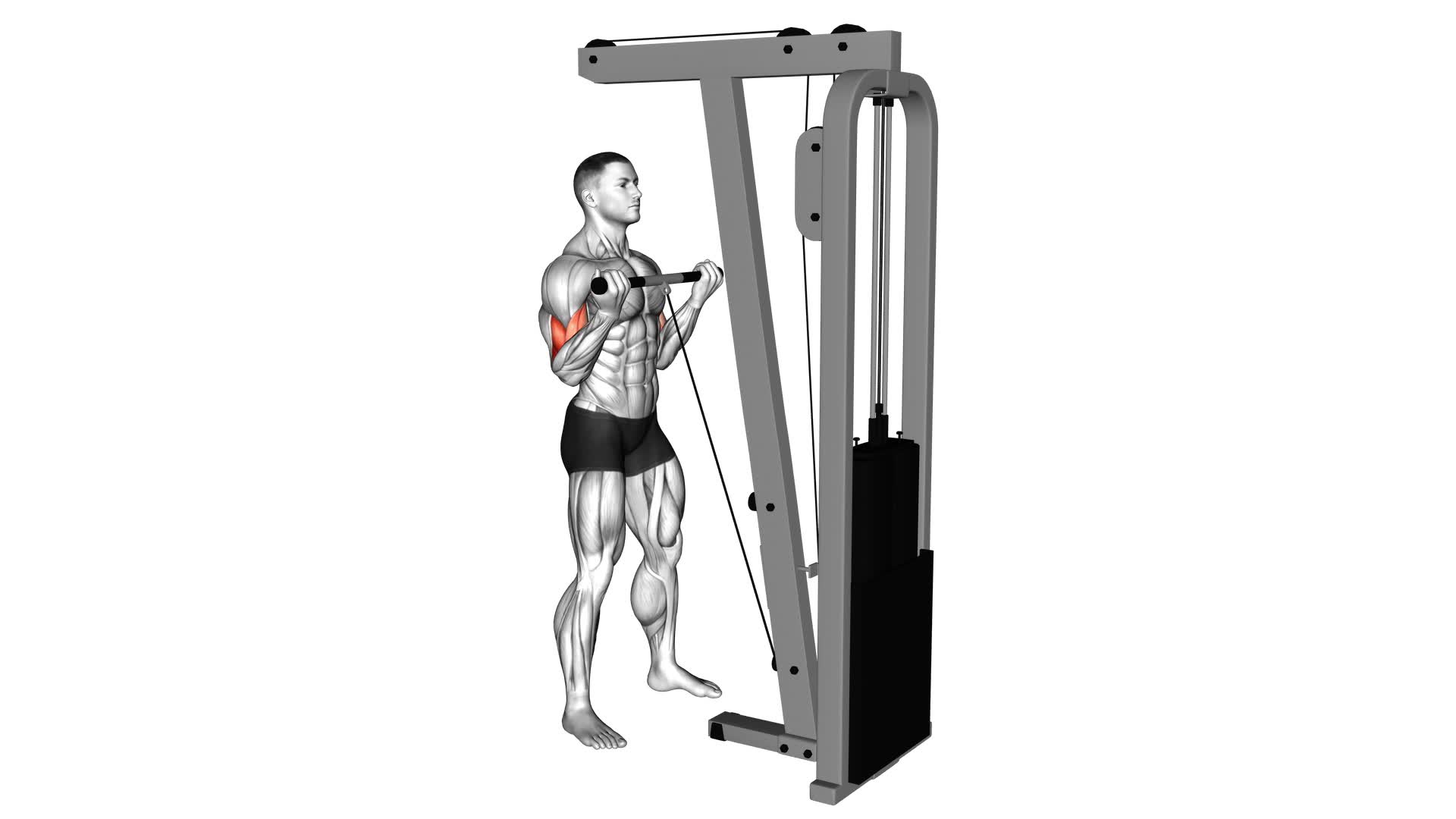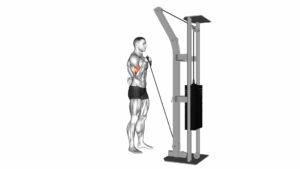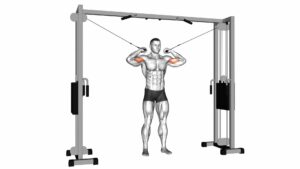Cable Curl – Video Exercise Guide & Tips

Looking to improve your biceps and strengthen your upper body? Look no further than cable curls! This video exercise guide and tips will show you the proper form and technique, variations to keep your workouts interesting, and common mistakes to avoid.
Watch This Exercise Video
Plus, we'll share some expert tips for maximizing your results. Get ready to sculpt those arms and make the most of your cable curl workouts. Let's get started!
Key Takeaways
- Cable curl strengthens the biceps and improves arm definition.
- Proper form and technique are crucial to maximize the benefits of cable curl.
- There are variations and modifications of cable curl exercises to target different muscles and prevent plateaus.
- To maximize results, focus on proper form and technique, implement progressive overload techniques, vary grip, and maintain controlled tempo.
Benefits of Cable Curl
To experience the benefits of cable curl, focus on strengthening your biceps and improving overall arm definition. Cable curl is an effective exercise that specifically targets the biceps muscles. Unlike other bicep exercises like dumbbell curls or barbell curls, cable curl provides a constant tension throughout the entire range of motion. This continuous tension helps to stimulate muscle growth and enhance muscle definition.
When compared to dumbbell curls, cable curl offers several advantages. Firstly, the cable machine allows for a greater range of motion, enabling you to fully stretch and contract your biceps. This increased range of motion helps to target the biceps muscles more effectively. Additionally, the constant tension provided by the cable machine ensures that the biceps are fully engaged throughout the exercise. This can lead to better muscle activation and overall strength gains.
Furthermore, cable curl allows for greater variation in grip and hand positioning. By utilizing different attachments and handles, you can target different areas of the biceps and add variety to your workout routine. This versatility can help prevent plateaus and keep your muscles challenged.
Proper Form and Technique
Maintain proper form and technique during cable curl by following these guidelines:
- Common misconceptions:
- Avoid using momentum to swing the weight. Keep your body still and use controlled movements to isolate your biceps.
- Don't grip the handle too tightly. Use a firm but relaxed grip to prevent excessive tension in your forearms and wrists.
- Avoid arching your back or leaning forward. Keep your core engaged and maintain a neutral spine throughout the exercise.
- Equipment recommendations:
- Choose a cable machine with adjustable weight stack or resistance bands that provide enough tension for an effective workout.
- Use a straight bar attachment or rope attachment for variety in your grip and to target different areas of your biceps.
- Ensure that the cable is securely attached to the machine and the handles are in good condition to prevent accidents or equipment failure.
Variations and Modifications
Try incorporating different variations and modifications of cable curls to target your biceps from various angles and intensify your workout. By incorporating alternative exercises and exploring different equipment options, you can add variety to your routine and challenge your muscles in new ways.
One alternative exercise to cable curls is the hammer curl. Instead of gripping the cable with your palms facing up, you'll hold the dumbbells with your palms facing each other. This variation shifts the focus to the brachialis and brachioradialis muscles, giving your biceps a different type of stimulation.
Another alternative exercise is the reverse curl. This exercise targets the brachialis and brachioradialis muscles even more than the hammer curl. To perform the reverse curl, simply grip the cable with your palms facing down and curl your forearms towards your shoulders.
In terms of equipment options, you can try using resistance bands instead of cables. Resistance bands provide a different type of resistance, challenging your muscles in a unique way. You can also experiment with different cable attachments, such as a straight bar or an EZ bar, to change the grip and angle of the exercise.
Incorporating these alternative exercises and equipment options into your cable curl routine can help prevent plateaus, stimulate muscle growth, and keep your workouts exciting. Remember to always use proper form and technique to maximize the effectiveness of each exercise.
Common Mistakes to Avoid
You should avoid these common mistakes when performing cable curls:
- Using too much weight: One of the most common mistakes is using too much weight, which can compromise your form and increase the risk of injury. Start with a lighter weight and focus on proper technique before gradually increasing the resistance.
- Swinging the body: Another common mistake is swinging the body to generate momentum instead of using the muscles properly. This takes away the tension from the target muscles and reduces the effectiveness of the exercise. Keep your body still and focus on isolating the biceps throughout the movement.
- Poor grip and hand placement: Technique errors in grip and hand placement can also hinder your progress. Avoid gripping the handles too tightly or using a grip that's too wide or narrow. Instead, maintain a firm but comfortable grip with your palms facing up, keeping your wrists in a neutral position.
By avoiding these common mistakes and focusing on proper form, you can maximize the benefits of cable curls and reduce the risk of injury.
Now, let's move on to the next section, where we'll discuss tips for maximizing results.
Tips for Maximizing Results
To maximize your results with cable curls, focus on implementing these effective tips.
One of the common misconceptions about cable curls is that using heavy weights is the only way to see progress. While it's important to challenge yourself, it's equally important to maintain proper form throughout the exercise. By using lighter weights and focusing on the mind-muscle connection, you can ensure that you're targeting the biceps effectively and reducing the risk of injury.
Another tip for maximizing results is to incorporate progressive overload techniques. Progressive overload involves gradually increasing the demands placed on your muscles over time. This can be done by increasing the weight, the number of repetitions, or the number of sets you perform. By gradually increasing the intensity of your cable curls, you can continue to challenge your muscles and stimulate growth.
Additionally, it's important to vary your grip during cable curls. By using different grips, such as underhand, overhand, or neutral grip, you can target different areas of the biceps and ensure balanced development.
Finally, make sure to maintain a controlled and slow tempo throughout the exercise, focusing on the eccentric (lowering) phase to fully engage the muscles.
Frequently Asked Questions
Can Cable Curls Help in Building Overall Arm Strength or Are They Mainly Focused on Bicep Development?
Cable curls are a great exercise to include in your full body workout routine. While they do primarily focus on bicep development, they also have several benefits for overall arm strength.
Cable curls engage your grip strength and forearm muscles, helping to improve them over time. By incorporating cable curls into your workout, you can target multiple muscle groups in your arms, leading to increased strength and definition.
Are There Any Specific Cable Curl Variations That Can Target Different Parts of the Biceps?
Cable curl variations offer a range of options to target different parts of your biceps. By adjusting grip variations and using different attachments, you can focus on specific areas for muscle development.
Cable curls also provide a resistance band alternative for those who prefer machines.
Incorporating cable curls into your workout routine at a frequency that suits you can lead to noticeable results in overall arm strength and bicep development.
Can Cable Curls Be Performed Using a Resistance Band Instead of a Cable Machine?
Yes, cable curls can be performed using a resistance band instead of a cable machine. This alternative allows you to still target your biceps effectively. However, using a cable machine offers certain benefits such as providing a constant tension throughout the movement.
Cable curls are great for building arm strength and can be modified with different grip variations to target different parts of the biceps. To see results, it's recommended to perform cable curls 1-2 times per week.
Is It Necessary to Use a Specific Grip (Such as Underhand or Overhand) While Performing Cable Curls?
When performing cable curls, it's important to use a specific grip that suits your goals. Different hand positions, such as underhand or overhand, can target different muscles in your arms. This variation allows you to work your biceps and forearms in different ways, leading to greater overall development.
Cable curls have the added benefit of providing constant tension throughout the movement, which can help stimulate muscle growth and improve muscle definition.
How Frequently Should Cable Curls Be Included in a Workout Routine to See Noticeable Results?
To see noticeable results, it's important to include cable curls in your workout routine with the right frequency. Cable curls can help strengthen your biceps and improve your overall arm definition.
Aim to do cable curls at least two to three times a week, allowing for proper rest and recovery. Consistency is key, so make sure to stick to your routine and gradually increase the weight and intensity to continue seeing progress.
Conclusion
To conclude, the cable curl is an effective exercise for targeting and strengthening the biceps. By maintaining proper form and technique, and avoiding common mistakes, you can maximize your results.
Additionally, incorporating variations and modifications can help challenge your muscles and prevent plateau. Remember to consult with a fitness professional or trainer if you have any concerns or questions.
Stay focused, consistent, and enjoy reaping the benefits of this exercise.

Author
Years ago, the spark of my life’s passion ignited in my mind the moment I stepped into the local gym for the first time. The inaugural bead of perspiration, the initial endeavor, the very first surge of endorphins, and a sense of pride that washed over me post-workout marked the beginning of my deep-seated interest in strength sports, fitness, and sports nutrition. This very curiosity blossomed rapidly into a profound fascination, propelling me to earn a Master’s degree in Physical Education from the Academy of Physical Education in Krakow, followed by a Sports Manager diploma from the Jagiellonian University. My journey of growth led me to gain more specialized qualifications, such as being a certified personal trainer with a focus on sports dietetics, a lifeguard, and an instructor for wellness and corrective gymnastics. Theoretical knowledge paired seamlessly with practical experience, reinforcing my belief that the transformation of individuals under my guidance was also a reflection of my personal growth. This belief holds true even today. Each day, I strive to push the boundaries and explore new realms. These realms gently elevate me to greater heights. The unique combination of passion for my field and the continuous quest for growth fuels my drive to break new ground.







